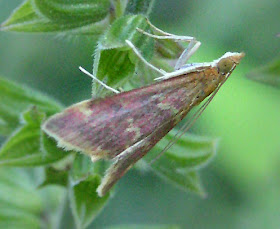 |
| Pine tree shedding pollen |
The
Pine Barrens of New Jersey is well worth a visit. The
Pinelands Preservation Alliance is dedicated to preserve this unique treasure. Let us take a look at some of the pollinators of its plant community.
The predominant tree and the one that gives the name to the place is the pine tree, especially the pitch pine (
Pinus rigida). It uses the wind for pollen transport. This ancient method of pollination existed long before there were any flowering plants or any pollen carriers. The features that make wind pollination possible are: the production of vast amounts of pollen and the relative proximity of plants to each other.
Some members of the flowering plants group have reverted to the time honored tradition of wind pollination; they do just fine without the help of pollinators. Such are oaks, birches, most maples, grasses and sedges, among others. Notice that such plants grow fairly close to each other and produce abundant pollen.
Plants that employ the services of pollinators invest some of their energy in producing flowers that attract and recompense the visitors. This investment is compensated by the reduced need to produce large amounts of pollen. Flowers have an array of different techniques to accomplish this. Here are some found in the Pine Barrens.
Sweetbay Magnolia (
Magnolia virginiana). Magnolias are among the oldest flowering plants. Their ancestors resorted to the only available pollinators at that time, rather clumsy ones, such as beetles. Beetles mouth parts are good for biting and chewing, not for delicately gathering pollen and nectar. They chew on the flowers along with feeding on some pollen and can make a big mess. Magnolias continue to be pollinated mostly by beetles and they tend to have rather tough, leathery petals to protect themselves against such insults.
Wild cherry (
Prunus serotina). The shape of its flowers is relatively simple and open, its pollen and nectar are easy to reach, thus a large number of species of bees and even other insects visit these flowers. Some of these flies mimic bees very skillfully and manage to fool not only hungry birds but even some human observers.
 |
| Mountain laurel in bloom |
Mountain laurel (
Kalmia latifolia). This attractive flower has a very peculiar shape. The anthers (the part of the flower that carries the pollen) remain caught inside little pockets made by the petals; their stalks or filaments remain taut and ready to snap. When an insect lands on the flower they spring to action. Each anther comes out of the pocket and gives the insect a good dusting of pollen.
Blueberries, cranberries (
Vaccinium corymbosum, Vaccinium macrocarpon and others). The anthers of these flowers are shaped very differently from those of most other flowers. They don’t split open exposing the pollen; instead they have an opening at the end of the anther. The way to get the pollen out requires some skillful work by the pollinator. It has to hang on to the flower and give it a good shake; the way you shake a salt shaker. Some bumblebees and many other native bees are very adept at this task. The blueberry bee (
Habropoda laboriosa), can pollinate so many flowers in her short adult life of a few weeks that her labor can result on $20 worth of blueberries, probably more at today’s prices.
Honey bees, on the other hand, never learned how to perform this task. They do visit blueberries and cranberries and accomplish pollination although not as efficiently as the native bees and bumblebees. However, large blueberry and cranberry operations resort to honey bees because of the convenience of placing hives on the fields and because such large tracts of land fail to provide nesting places for native bees. Pollinating these berries is stressful for honey bees; they are not well adapted to such diet and suffer as a consequence. Wild grown berries, on the other hand, get all their needed pollination from native bees.
Lady slipper (
Cypripedium acaule). The lovely orchid known as lady slipper can play unpleasant tricks on pollinators; its elaborate shape is nothing but a seductive trap with a complicated escape route. The flower yields an aroma that some bees find irresistible. When they reach the flower, they perch at the edge of the sac and frequently slip and fall. Soon they find that they can’t get out the way they came in because the inside walls are very slippery and the lip of the sac curves inwards making it even harder. Fortunately the orchid has provided a ladder at the back of the flower and a very narrow passage that leads back to freedom. The bee that struggles through this tunnel gets a sac of pollen, called pollinia, stuck to its back. It will remember the unfortunate experience long enough to move away from that patch of orchids; but shortly afterward, it will be quite willing to repeat the experience because its little brain will have forgotten all about it.
Magnolias and Beetle Pollination
Lady slipper
List of articles
© Beatriz Moisset. 2012















